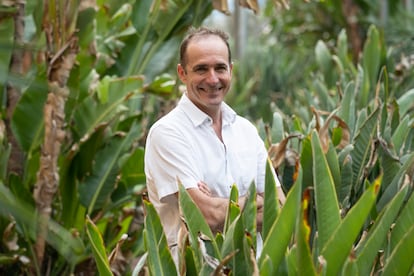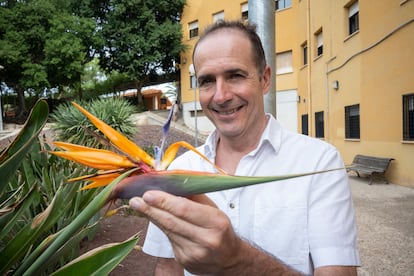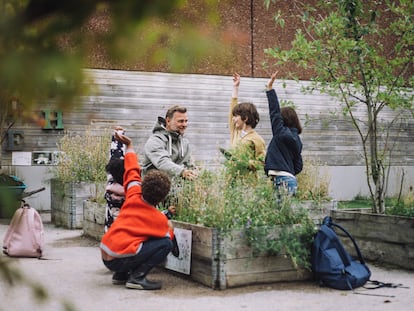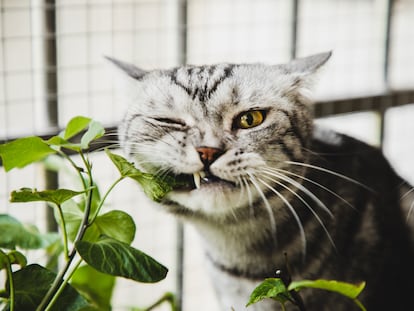Paco Calvo, a philosopher of plant behavior: ‘Roots do amazing things and can communicate future stress’
The author of ‘Planta sapiens’ investigates the intelligence of plants and the ways in which they communicate, evaluate risks, and make decisions


While convalescing from illness in 1862, Charles Darwin was fascinated by the way cucumber plants climbed, as well as their movements and habits, which he described in a novel academic work. “With the naked eye, Darwin saw patterns of behavior in plants that we are still not able to see today with time-lapse [photography],” says Paco Calvo, professor of philosophy of science. Eight years ago, the English naturalist’s curiosity inspired Calvo to set up the Minimum Intelligence Laboratory (Mint Lab) at the University of Murcia, where he strives to “see plants through a different lens.” Now he has published Planta Sapiens: Unmasking Plant Intelligence, a surprising essay that investigates the intelligence of plants and the ways in which plant life communicates, evaluates risks and makes decisions.
Question. Why did you set up the Mint Lab?
Answer. I worked on the theoretical framework to understand plant intelligence, and I saw that in other disciplines they were not even close to asking the questions we were asking. We wanted to carry out plant psychology experiments to test the hypothesis that plants learn, memorize, and make decisions, and that their behavior is flexible. We use the same experimental protocols that have been published in the literature on animal experiments, which we are adapting to study a subject that does not move like an animal. Then you have to interpret the data, and that brings you back to the theoretical part. We interweave theoretical, philosophical, experimental, and empirical work.
Q. How are plants intelligent?
A. They are intelligent in their own way. We have to stop navel-gazing and looking for intelligence that looks like ours. Plants have their own problems and provide their own solutions. If I have roots, you can’t ask me to run away when a predator comes. But we can find the key: for me it is to distinguish between a merely adaptive behavior and the behavioral repertoire in the face of specific adversities. You need that flexible behavior to be anticipatory. In plants, this need to anticipate is even more important because they are sessile: they do not move. If a climbing plant takes a long time to reach the host tree it can be fatal. Intelligence is a behavior that, apart from being adaptive, must be sufficiently flexible, anticipatory, and goal oriented.
Q. We see plants as passive. Should we think of them differently?
A. Yes. Plants are neither slow nor fast, they grow at the optimal speed for them. Slow is from our frame of reference. We can use time-lapse photography to accelerate plants’ behavior and appreciate it from our observation timescale. Plants are anything but passive, however.
Q. Can they learn?
A. It’s an empirical hypothesis, like saying that a bee or an octopus can learn. You don’t have to believe it out of dogma, you have to test it, as we do in the Mint Lab. The mistake would be to rule out the possibility that plant learning existed because they lack neurons. So far, learning has been linked to how we modify the synapses between our neurons, but if we consider that any life form can learn or not, thanks to the substrate it is in, we can customize the experiments. Can plants learn? Obviously. Is there evidence that there is a certain form of learning? No, we are working on it, when we have solid results, we’ll be able to share them with the scientific community.
Q. Do plants communicate?
A. Yes, in many ways: by air, through volatile organic compounds, which is something they use to communicate either with other parts of the same plant or with distant plants. Plants are sensitive to a large number of biotic and abiotic parameters: they monitor external and internal information, and they have perception of their own body and where they are with respect to whom. The plant also has to communicate within its own body so as to optimize its resources. Communication is mediated by hormones, and there are signaling pathways involving electric and magnetic fields. That information is transmitted through the roots. Bioelectricity is fundamental, [their communication] is not all phytohormones. There is an infinite number of channels and sources of information that they have to analyze in real time.
Q. The book starts with an experiment in which you anesthetize a mimosa, the plants that retract their leaves when touched. So, do they have a certain kind of consciousness?
A. This is very controversial. When we talk about consciousness or intelligence in the case of animals, we forget that intelligence or consciousness is not something we can observe: we can only infer it from behavior. We’re opening a big can of worms when we talk about there being animal intelligence outside of mammals with cerebral cortex. One of the indicators used by the scientific community is the role of anesthesia: how a subject responds to being exposed to a molecule that temporarily disables it from performing its usual behavior patterns. I do not have direct access to the animal’s awareness, but I see that with the anesthetic it loses something that it later recovers. What does it mean to recover from anesthesia? A return of our consciousness. If we overcome that initial prejudice, we know that anesthesia alters the membrane properties of plant cells, which is the same thing that happens with neurons. If the underlying mechanism is the same, why don’t we come to the same conclusion when it’s a plant? Because of a prejudice. The powerful intuition is that plants recover their awareness.
Q. What’s the most amazing thing you’ve seen a plant do?
A. If I see a climbing plant winding itself around a stake and I accelerate its movement, I am able to appreciate it because it looks like something we would do. But why does it have to look similar? A boring growth pattern can underlie something very important, as can be seen if we insert electrodes and record the electrical activity of the plant. We suffer from blindness with plants: half of the plant is in the subsoil, and amazing things happen in the roots. They do amazing things. The roots can communicate situations of future stress: if you have several plants with roots in different pots, and whose roots communicate, if the first pot is subjected to chemical or water stress, and the next two are not, the first communicates stress to the others and the plants begin to shut down and reduce their metabolism. It is the ability to anticipate moderated by communication between individuals.

Q. How do plants react to predators?
A. One of the most fascinating examples is that of tomato plants that turn the caterpillars that attack them into cannibals: they secrete substances that make the plant unappetizing for the caterpillar and it ends up eating the caterpillar next to it. Other plants hire a bodyguard: if a herbivore is eating the plant, it sends a chemical signal that attracts the herbivore’s natural predator to remove the threat.
Q. Darwin was the first to start talking about plant behaviors. So, do they have a behavior?
A. Yes. In plants, behavior manifests itself in the form of phenotypic plasticity: put plainly, patterns of development and growth.
Q. And personality?
A. We must distinguish merely adaptive behavior from rich, flexible, anticipatory patterns of learning. If there is learning, it will occur in connection with the individual’s exposure to the environment: a dog that has been beaten and another that has been petted will behave differently. In the case of plants, we see that not everything can be written in the genes, and that a lot has to do with their interaction with the environment, so different individuals are going to behave differently because of their experience.
Q. Do plants listen?
A. There are good indications that yes, there is a lot of work in phytoacoustics (plant acoustics) and it is fascinating. But it is very recent, and we have to carry out experiments in independent laboratories. The plant is sensitive to waves, which impact its body surface, and that is information that it processes.
Q. Do they sleep?
A. You have to shake off the labels again. Legumes, for example, fold their leaves at night and unfold them in the morning. If you can’t sleep, you buy melatonin at the pharmacy. Plants biosynthesize their own melatonin and the peak melatonin concentration coincides with that time of leaf folding to “go to bed,” just like in animals. The molecule is the same, but when the scientific community accepted it, they decided to call it phyto-melatonin. There must be some coincidence in the fact that the concentrations, the peak and the valley, coincide with the time that the leaves fold when it gets dark. What is the answer? They have circadian clocks, just like us. All life needs rest, but they do not need a REM phase.
Q. Does behavior change between agricultural and wild plants?
A. Agriculture has been sculpting the phenotype of plants and making things easy for them: for example, I give my climbing plant a cane and it grows well. In this domesticated climber, the distance between the nodes in the stem is shortened, so the plant makes more rigid movements and does not make a big loop like a wild plant. It has a secure stick and does not need to go out to explore. If I have an overhead camera to record the movement pattern, I will be able to see from above how the plant is growing and oscillating, and I see that circle. If you go to a wild plant, you will see that the movements are much more erratic, irregular, and zigzagging, because the phenotype of the plant is different. Its movement is not circumscribed to such a rigid circular pattern. Its behavior will vary as it grows.
Q. The Pentagon contributed funds to the Minimal Intelligence Laboratory. What interests them about your work?
A. Until last December, we had a project with the Department of Defense on plant bioinspiration for robotics and artificial intelligence. When you inspire a lunar robot — like a rover — in the animal model, you inherit the advantages and disadvantages of that model: it can move fast, but if it gets caught in a crack the exploration is over. We are researching growots (robots that grow) and that removes all the problems related to locomotion. That is, they would grow over the crack. If our models of robotics are not inspired by plant systems, or biological systems other than those of locomotion, we’ll miss out on a lot of opportunities.
Sign up for our weekly newsletter to get more English-language news coverage from EL PAÍS USA Edition
Tu suscripción se está usando en otro dispositivo
¿Quieres añadir otro usuario a tu suscripción?
Si continúas leyendo en este dispositivo, no se podrá leer en el otro.
FlechaTu suscripción se está usando en otro dispositivo y solo puedes acceder a EL PAÍS desde un dispositivo a la vez.
Si quieres compartir tu cuenta, cambia tu suscripción a la modalidad Premium, así podrás añadir otro usuario. Cada uno accederá con su propia cuenta de email, lo que os permitirá personalizar vuestra experiencia en EL PAÍS.
¿Tienes una suscripción de empresa? Accede aquí para contratar más cuentas.
En el caso de no saber quién está usando tu cuenta, te recomendamos cambiar tu contraseña aquí.
Si decides continuar compartiendo tu cuenta, este mensaje se mostrará en tu dispositivo y en el de la otra persona que está usando tu cuenta de forma indefinida, afectando a tu experiencia de lectura. Puedes consultar aquí los términos y condiciones de la suscripción digital.
More information
Archived In
Últimas noticias
Most viewed
- Reinhard Genzel, Nobel laureate in physics: ‘One-minute videos will never give you the truth’
- Oona Chaplin: ‘I told James Cameron that I was living in a treehouse and starting a permaculture project with a friend’
- Pablo Escobar’s hippos: A serious environmental problem, 40 years on
- Why we lost the habit of sleeping in two segments and how that changed our sense of time
- Chevy Chase, the beloved comedian who was a monster off camera: ‘Not everyone hated him, just the people who’ve worked with him’










































